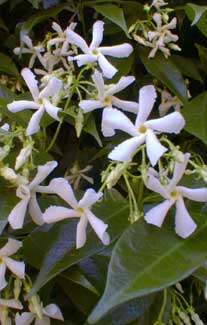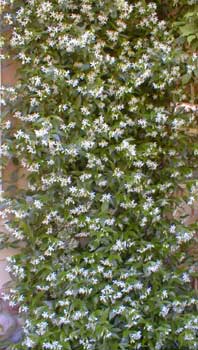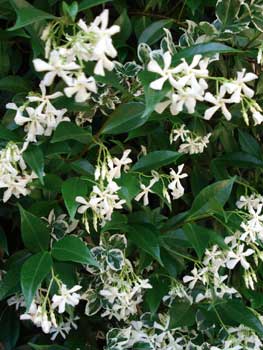
Star Jasmine
"Around lay blossoms that filled the air
With perfume, snow of flowers that hid
The snow of the silken coverlid
With myrtle & orange bloom & store
Of jasmine stars."
-John Arthur Goodchild
(b.1851)
(b.1851)
 Star Jasmine (Trachelospermum jasminoides) is not a true jasmine but is so-named because of its rich perfume. The one-inch white pinwheel flowers are extremely numerous & sweetly redolent.
Star Jasmine (Trachelospermum jasminoides) is not a true jasmine but is so-named because of its rich perfume. The one-inch white pinwheel flowers are extremely numerous & sweetly redolent.It flowers mainly in spring & early summer, beginning as early as April & not slowing down until July. A few more flowers will occur to the very end of summer. It's a good vine to place near doorway or a much-used path in order to most appreciate its fragrance.
Because of its popularity in the South it is often called Confederate Jasmine, without regard for the fact that it is actually from China, but many people dislike that common name because of the slavery connotations of the Confederacy & the use of the Confederate flag by racists. For most of the country, it is called Star Jasmine.
Star jasmine is a deep green evergreen vine that will climb to fifteen feet (& potentially thirty or forty feet) self-clinging on a sunny wall. It can be kept within a given size by periodic pruning. It will not harm masonry but vines can find their way under shingles.
It will quickly fill a trellis or cover a stump or pillar. It will either climb up or cascade down a high retaining wall. It is a bit sensitive to frost, so needs protection from cold winter wind. In areas with many frosty days it does best against the warmth of a house or growing around a door or window, as this one is doing.
 It should be fully hardy in a sunny location in Zone 8. In Zones 9 & 10 it may want a bit of afternoon shade to protect it from scald. Also in Zone 9 or 10 it can be used as a groundcover or on a slope, but in Zone 8 the ground may expose its leaves to too much frost.
It should be fully hardy in a sunny location in Zone 8. In Zones 9 & 10 it may want a bit of afternoon shade to protect it from scald. Also in Zone 9 or 10 it can be used as a groundcover or on a slope, but in Zone 8 the ground may expose its leaves to too much frost.Some people allow star jasmine to climb trees, but over time it can become very thick blocking sunlight from tree branches, & add a great deal of weight to the branches while at the same time increasing wind resistance, hence hightening the risk of blow-down.
This is a risk that can be said equally of wisteria, ivy, trumpet vines, kiwi, Virginia creeper or any number of potentially heavy climbers. Yet often a tree manages perfectly well with star jasmine, which in itself causes no physical damage.
It can take a year or two to get a good root system, after which it becomes vigorous. That first year or two it is more at risk of winter death or summer drought injury, but eventually it will no longer need babying.
The leaves are used to brew tonic teas & herbal remedies in China, believed to be useful for problems of old age such as arthritis & heart disease. Research done in Australia [Li, et al, 2003] indicate that this plant really does contain chemical enzymes that function as anti-inflammatories.